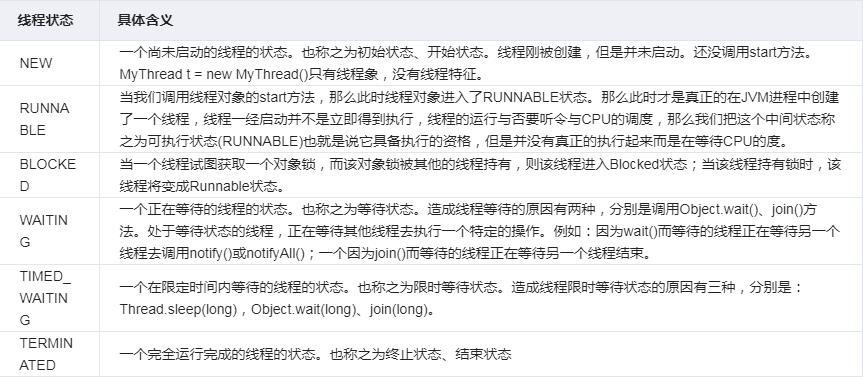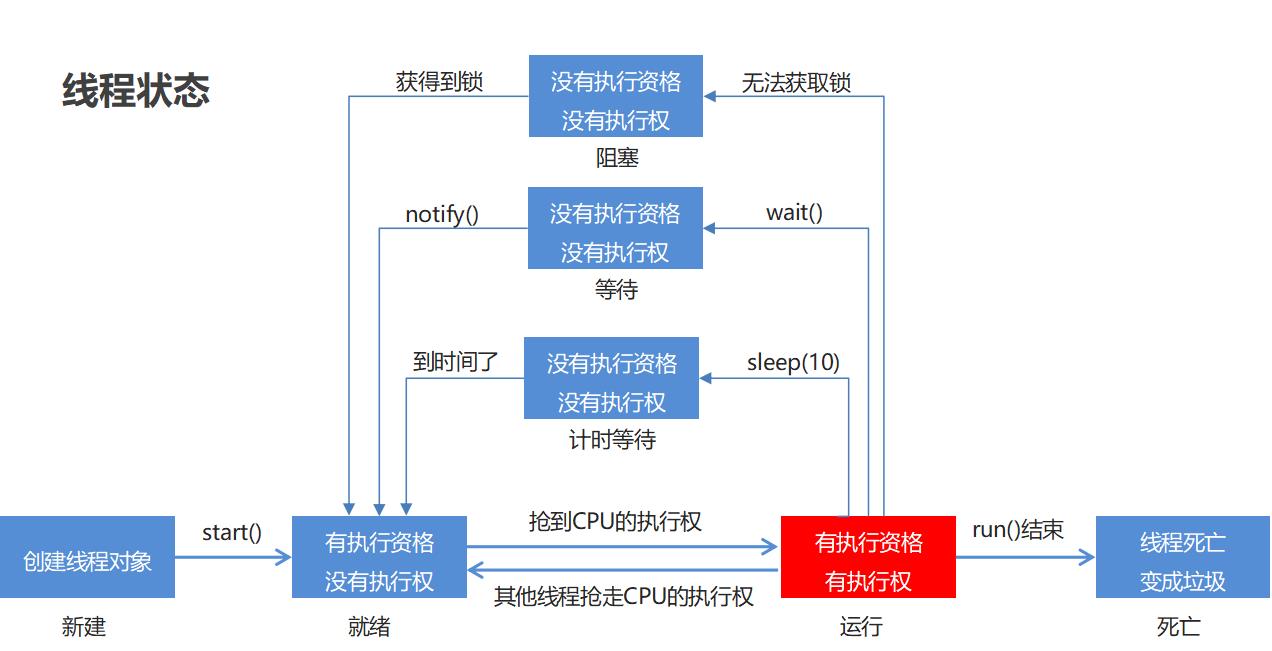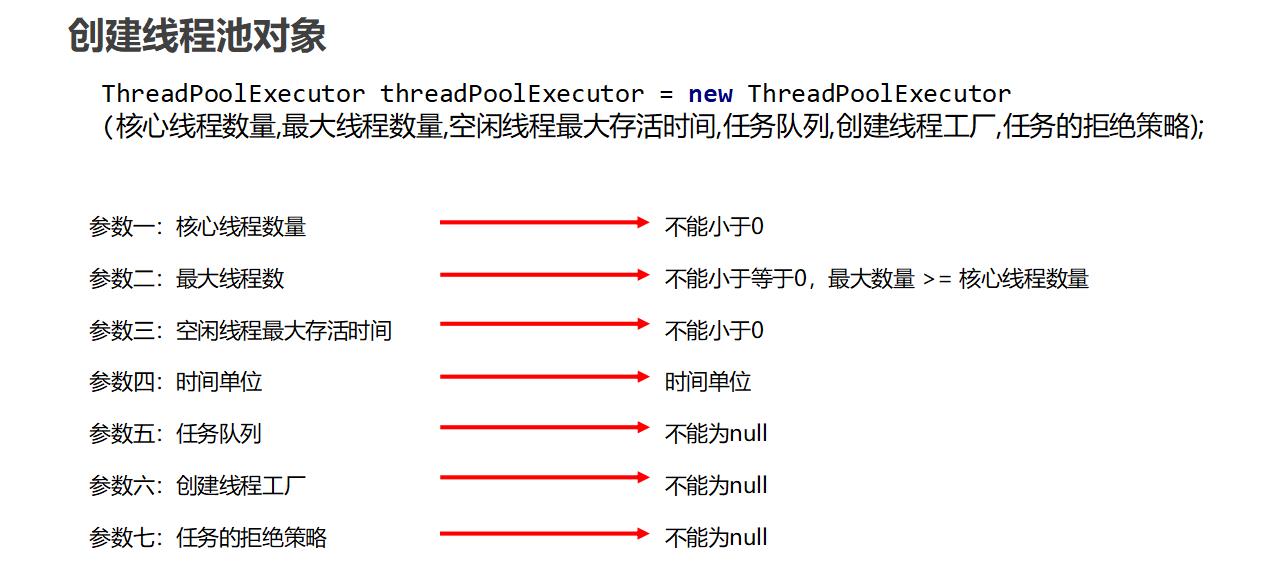阿里年薪80W架构师2W字多线程进阶(线程池原子性并发工具类)超详细笔记
Posted 益达学长
tags:
篇首语:本文由小常识网(cha138.com)小编为大家整理,主要介绍了阿里年薪80W架构师2W字多线程进阶(线程池原子性并发工具类)超详细笔记相关的知识,希望对你有一定的参考价值。

线程池
线程状态介绍
当线程被创建并启动以后,它既不是一启动就进入了执行状态,也不是一直处于执行状态。线程对象在不同的时期有不同的状态。那么Java中的线程存在哪几种状态呢?Java中的线程
状态被定义在了java.lang.Thread.State枚举类中,State枚举类的源码如下:
public class Thread {
public enum State {
/* 新建 */
NEW ,
/* 可运行状态 */
RUNNABLE ,
/* 阻塞状态 */
BLOCKED ,
/* 无限等待状态 */
WAITING ,
/* 计时等待 */
TIMED_WAITING ,
/* 终止 */
TERMINATED;
}
// 获取当前线程的状态
public State getState() {
return jdk.internal.misc.VM.toThreadState(threadStatus);
}
}
通过源码我们可以看到Java中的线程存在6种状态,每种线程状态的含义如下

线程池-基本原理
概述 :
提到池,大家应该能想到的就是水池。水池就是一个容器,在该容器中存储了很多的水。那么什么是线程池呢?线程池也是可以看做成一个池子,在该池子中存储很多个线程。
线程池存在的意义:
系统创建一个线程的成本是比较高的,因为它涉及到与操作系统交互,当程序中需要创建大量生存期很短暂的线程时,频繁的创建和销毁线程对系统的资源消耗有可能大于业务处理是对系统资源的消耗,这样就有点"舍本逐末"了。针对这一种情况,为了提高性能,我们就可以采用线程池。线程池在启动的时,会创建大量空闲线程,当我们向线程池提交任务的时,线程池就会启动一个线程来执行该任务。等待任务执行完毕以后,线程并不会死亡,而是再次返回到线程池中称为空闲状态。等待下一次任务的执行。
线程池的设计思路 :
- 准备一个任务容器
- 一次性启动多个(2个)消费者线程
- 刚开始任务容器是空的,所以线程都在wait
- 直到一个外部线程向这个任务容器中扔了一个"任务",就会有一个消费者线程被唤醒
- 这个消费者线程取出"任务",并且执行这个任务,执行完毕后,继续等待下一次任务的到来
线程池-Executors默认线程
概述 : JDK对线程池也进行了相关的实现,在真实企业开发中我们也很少去自定义线程池,而是使用JDK中自带的线程池。
我们可以使用Executors中所提供的静态方法来创建线程池
代码实现 :
//static ExecutorService newCachedThreadPool() 创建一个默认的线程池
//static ExecutorService newFixedThreadPool(int nThreads) 创建一个指定最多线程数量的线程池
import java.util.concurrent.ExecutorService;
import java.util.concurrent.Executors;
public class MyThreadPoolDemo {
public static void main(String[] args) throws InterruptedException {
//1,创建一个默认的线程池对象.池子中默认是空的.默认最多可以容纳int类型的最大值.
ExecutorService executorService = Executors.newCachedThreadPool();
//Executors --- 可以帮助我们创建线程池对象
//ExecutorService --- 可以帮助我们控制线程池
executorService.submit(()->{
System.out.println(Thread.currentThread().getName() + "在执行了");
});
//Thread.sleep(2000);
executorService.submit(()->{
System.out.println(Thread.currentThread().getName() + "在执行了");
});
executorService.shutdown();
}
}
线程池-Executors创建指定
使用Executors中所提供的静态方法来创建线程池
代码实现 :
//static ExecutorService newFixedThreadPool(int nThreads)
//创建一个指定最多线程数量的线程池
import java.util.concurrent.ExecutorService;
import java.util.concurrent.Executors;
import java.util.concurrent.ThreadPoolExecutor;
public class MyThreadPoolDemo2 {
public static void main(String[] args) {
//参数不是初始值而是最大值
ExecutorService executorService = Executors.newFixedThreadPool(10);
ThreadPoolExecutor pool = (ThreadPoolExecutor) executorService;
System.out.println(pool.getPoolSize());//0
executorService.submit(()->{
System.out.println(Thread.currentThread().getName() + "在执行了");
});
executorService.submit(()->{
System.out.println(Thread.currentThread().getName() + "在执行了");
});
System.out.println(pool.getPoolSize());//2
// executorService.shutdown();
}
}
线程池-ThreadPoolExecutor
创建线程池对象 :
ThreadPoolExecutor threadPoolExecutor = new ThreadPoolExecutor(核心线程数量,最大线程数量,空闲线程最大存活时间,任务队列,创建线程工厂,任务的拒绝策略);
代码实现 :
import java.util.concurrent.ArrayBlockingQueue;
import java.util.concurrent.Executors;
import java.util.concurrent.ThreadPoolExecutor;
import java.util.concurrent.TimeUnit;
public class MyThreadPoolDemo3 {
// 参数一:核心线程数量
// 参数二:最大线程数
// 参数三:空闲线程最大存活时间
// 参数四:时间单位 ---TimeUnit
// 参数五:任务队列 ---让任务在队列里等着,等有线程空闲了,再从队列中获取任务并执行
// 参数六:创建线程工厂 ---按照默认方式创建线程对象
// 参数七:任务的拒绝策略 ---什么时候拒绝任务:提交的任务 > 池子中最大线程数 + 队列容量
public static void main(String[] args) {
ThreadPoolExecutor pool = new ThreadPoolExecutor(2,5,2,TimeUnit.SECONDS,new ArrayBlockingQueue<>(10), Executors.defaultThreadFactory(),new ThreadPoolExecutor.AbortPolicy());
pool.submit(new MyRunnable());
pool.submit(new MyRunnable());
pool.shutdown();
}
}
线程池-参数详解
public ThreadPoolExecutor(int corePoolSize,
int maximumPoolSize,
long keepAliveTime,
TimeUnit unit,
BlockingQueue<Runnable> workQueue,
ThreadFactory threadFactory,
RejectedExecutionHandler handler)
corePoolSize: 核心线程的最大值,不能小于0
maximumPoolSize:最大线程数,不能小于等于0,maximumPoolSize >= corePoolSize
keepAliveTime: 空闲线程最大存活时间,不能小于0
unit: 时间单位
workQueue: 任务队列,不能为null
threadFactory: 创建线程工厂,不能为null
handler: 任务的拒绝策略,不能为null
线程池-非默认任务拒绝策略
RejectedExecutionHandler是jdk提供的一个任务拒绝策略接口,它下面存在4个子类。
ThreadPoolExecutor.AbortPolicy: 丢弃任务并抛出RejectedExecutionException异常。是默认的策略。
ThreadPoolExecutor.DiscardPolicy: 丢弃任务,但是不抛出异常 这是不推荐的做法。
ThreadPoolExecutor.DiscardOldestPolicy: 抛弃队列中等待最久的任务 然后把当前任务加入队列中。
ThreadPoolExecutor.CallerRunsPolicy: 调用任务的run()方法绕过线程池直接执行。
注:明确线程池对多可执行的任务数 = 队列容量 + 最大线程数
案例演示1:演示ThreadPoolExecutor.AbortPolicy任务处理策略
public class ThreadPoolExecutorDemo01 {
public static void main(String[] args) {
/**
* 核心线程数量为1 , 最大线程池数量为3, 任务容器的容量为1 ,空闲线程的最大存在时间为20s
*/
ThreadPoolExecutor threadPoolExecutor = new ThreadPoolExecutor(1 , 3 , 20 , TimeUnit.SECONDS ,
new ArrayBlockingQueue<>(1) , Executors.defaultThreadFactory() , new ThreadPoolExecutor.AbortPolicy()) ;
// 提交5个任务,而该线程池最多可以处理4个任务,当我们使用AbortPolicy这个任务处理策略的时候,就会抛出异常
for(int x = 0 ; x < 5 ; x++) {
threadPoolExecutor.submit(() -> {
System.out.println(Thread.currentThread().getName() + "---->> 执行了任务");
});
}
}
}
控制台输出结果
pool-1-thread-1---->> 执行了任务
pool-1-thread-3---->> 执行了任务
pool-1-thread-2---->> 执行了任务
pool-1-thread-3---->> 执行了任务
控制台报错,仅仅执行了4个任务,有一个任务被丢弃了
案例演示2:演示ThreadPoolExecutor.DiscardPolicy任务处理策略
public class ThreadPoolExecutorDemo02 {
public static void main(String[] args) {
/**
* 核心线程数量为1 , 最大线程池数量为3, 任务容器的容量为1 ,空闲线程的最大存在时间为20s
*/
ThreadPoolExecutor threadPoolExecutor = new ThreadPoolExecutor(1 , 3 , 20 , TimeUnit.SECONDS ,
new ArrayBlockingQueue<>(1) , Executors.defaultThreadFactory() , new ThreadPoolExecutor.DiscardPolicy()) ;
// 提交5个任务,而该线程池最多可以处理4个任务,当我们使用DiscardPolicy这个任务处理策略的时候,控制台不会报错
for(int x = 0 ; x < 5 ; x++) {
threadPoolExecutor.submit(() -> {
System.out.println(Thread.currentThread().getName() + "---->> 执行了任务");
});
}
}
}
控制台输出结果
pool-1-thread-1---->> 执行了任务
pool-1-thread-1---->> 执行了任务
pool-1-thread-3---->> 执行了任务
pool-1-thread-2---->> 执行了任务
控制台没有报错,仅仅执行了4个任务,有一个任务被丢弃了
案例演示3:演示ThreadPoolExecutor.DiscardOldestPolicy任务处理策略
public class ThreadPoolExecutorDemo02 {
public static void main(String[] args) {
/**
* 核心线程数量为1 , 最大线程池数量为3, 任务容器的容量为1 ,空闲线程的最大存在时间为20s
*/
ThreadPoolExecutor threadPoolExecutor;
threadPoolExecutor = new ThreadPoolExecutor(1 , 3 , 20 , TimeUnit.SECONDS ,
new ArrayBlockingQueue<>(1) , Executors.defaultThreadFactory() , new ThreadPoolExecutor.DiscardOldestPolicy());
// 提交5个任务
for(int x = 0 ; x < 5 ; x++) {
// 定义一个变量,来指定指定当前执行的任务;这个变量需要被final修饰
final int y = x ;
threadPoolExecutor.submit(() -> {
System.out.println(Thread.currentThread().getName() + "---->> 执行了任务" + y);
});
}
}
}
控制台输出结果
pool-1-thread-2---->> 执行了任务2
pool-1-thread-1---->> 执行了任务0
pool-1-thread-3---->> 执行了任务3
pool-1-thread-1---->> 执行了任务4
由于任务1在线程池中等待时间最长,因此任务1被丢弃。
案例演示4:演示ThreadPoolExecutor.CallerRunsPolicy任务处理策略
public class ThreadPoolExecutorDemo04 {
public static void main(String[] args) {
/**
* 核心线程数量为1 , 最大线程池数量为3, 任务容器的容量为1 ,空闲线程的最大存在时间为20s
*/
ThreadPoolExecutor threadPoolExecutor;
threadPoolExecutor = new ThreadPoolExecutor(1 , 3 , 20 , TimeUnit.SECONDS ,
new ArrayBlockingQueue<>(1) , Executors.defaultThreadFactory() , new ThreadPoolExecutor.CallerRunsPolicy());
// 提交5个任务
for(int x = 0 ; x < 5 ; x++) {
threadPoolExecutor.submit(() -> {
System.out.println(Thread.currentThread().getName() + "---->> 执行了任务");
});
}
}
}
控制台输出结果
pool-1-thread-1---->> 执行了任务
pool-1-thread-3---->> 执行了任务
pool-1-thread-2---->> 执行了任务
pool-1-thread-1---->> 执行了任务
main---->> 执行了任务
通过控制台的输出,我们可以看到次策略没有通过线程池中的线程执行任务,而是直接调用任务的run()方法绕过线程池直接执行。
阿里巴巴关于线程池的规范
-
阿里巴巴Java开发手册
【强制】创建线程或线程池时请指定有意义的线程名称,方便出错时回溯。
【强制】线程资源必须通过线程池提供,不允许在应用中自行显式创建线程。
【强制】线程池不允许使用 Executors 去创建,而是通过 ThreadPoolExecutor 的方式,这样的处理方式让写的同学更加明确线程池的运行规则,规避资源耗尽的风险。 -
禁止直接使用Executors创建线程池原因:
FixedThreadPool和SingleThreadPool:
允许的请求队列长度为Integer.MAX_VALUE,可能会堆积大量的请求,从而导致OOM(Out Of Memory)。
CachedThreadPool和ScheduledThreadPool:
允许的创建线程数量为Integer.MAX_VALUE,可能会创建大量的线程,从而导致OOM。
原子性
volatile-问题
代码分析 :
public class Demo {
public static void main(String[] args) {
MyThread1 t1 = new MyThread1();
t1.setName("小路同学");
t1.start();
MyThread2 t2 = new MyThread2();
t2.setName("小皮同学");
t2.start();
}
}
public class Money {
public static int money = 100000;
}
public class MyThread1 extends Thread {
@Override
public void run() {
while(Money.money == 100000){
}
System.out.println("结婚基金已经不是十万了");
}
}
public class MyThread2 extends Thread {
@Override
public void run() {
try {
Thread.sleep(10);
} catch (InterruptedException e) {
e.printStackTrace();
}
Money.money = 90000;
}
}
程序问题: 女孩虽然知道结婚基金是十万,但是当基金的余额发生变化的时候,女孩无法知道最新的余额。
volatile解决
以上案例出现的问题 :
当A线程修改了共享数据时,B线程没有及时获取到最新的值,如果还在使用原先的值,就会出现问题
1,堆内存是唯一的,每一个线程都有自己的线程栈。
2 ,每一个线程在使用堆里面变量的时候,都会先拷贝一份到变量的副本中。
3 ,在线程中,每一次使用是从变量的副本中获取的。
Volatile关键字 : 强制线程每次在使用的时候,都会看一下共享区域最新的值
代码实现 : 使用volatile关键字解决
public class Demo {
public static void main(String[] args) {
MyThread1 t1 = new MyThread1();
t1.setName("小路同学");
t1.start();
MyThread2 t2 = new MyThread2();
t2.setName("小皮同学");
t2.start();
}
}
public class Money {
public static volatile int money = 100000;
}
public class MyThread1 extends Thread {
@Override
public void run() {
while(Money.money == 100000){
}
System.out.println("结婚基金已经不是十万了");
}
}
public class MyThread2 extends Thread {
@Override
public void run() {
try {
Thread.sleep(10);
} catch (InterruptedException e) {
e.printStackTrace();
}
Money.money = 90000;
}
}
synchronized解决
synchronized解决 :
1 ,线程获得锁
2 ,清空变量副本
3 ,拷贝共享变量最新的值到变量副本中
4 ,执行代码
5 ,将修改后变量副本中的值赋值给共享数据
6 ,释放锁
代码实现 :
public class Demo {
public static void main(String[] args) {
MyThread1 t1 = new MyThread1();
t1.setName("小路同学");
t1.start();
MyThread2 t2 = new MyThread2();
t2.setName("小皮同学");
t2.start();
}
}
public class Money {
public static Object lock = new Object();
public static volatile int money = 100000;
}
public class MyThread1 extends Thread {
@Override
public void run() {
while(true){
synchronized (Money.lock){
if(Money.money != 100000){
System.out.println("结婚基金已经不是十万了");
break以上是关于阿里年薪80W架构师2W字多线程进阶(线程池原子性并发工具类)超详细笔记的主要内容,如果未能解决你的问题,请参考以下文章




